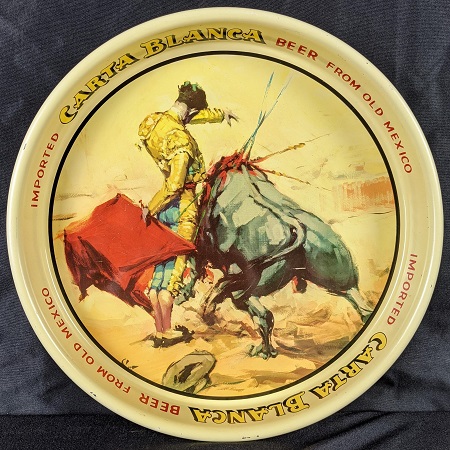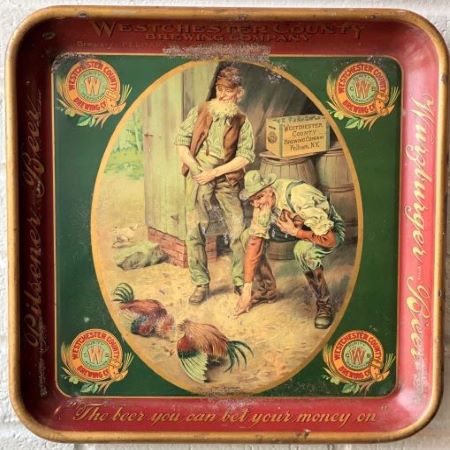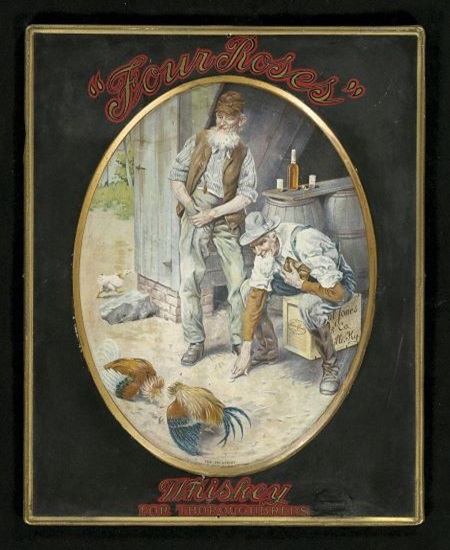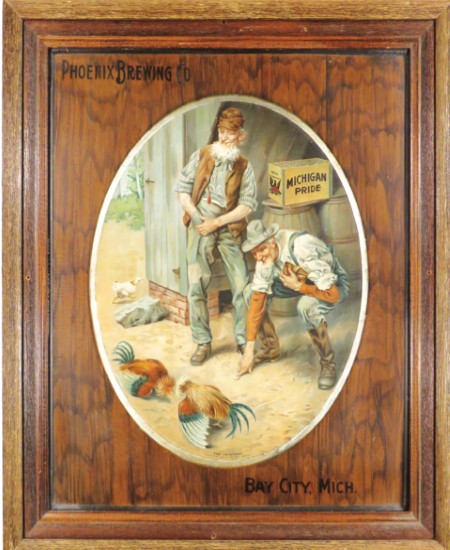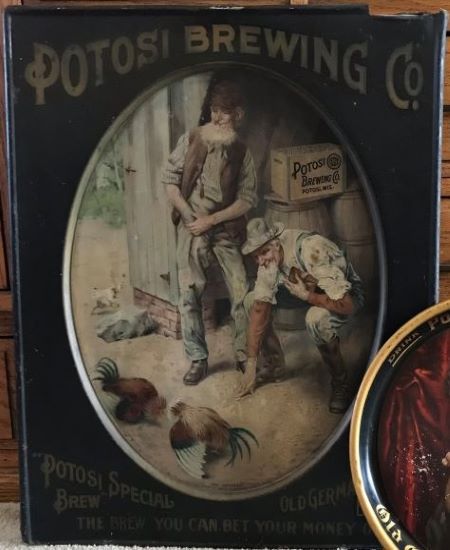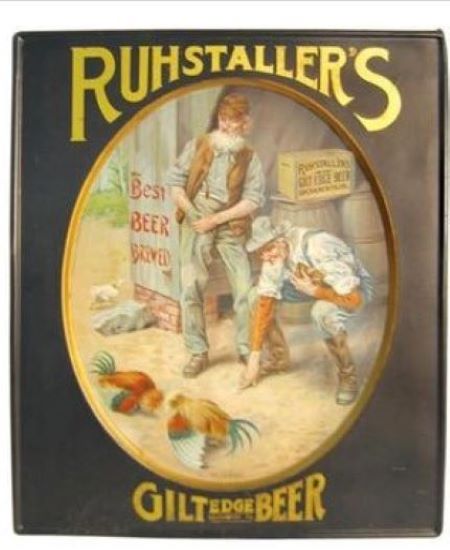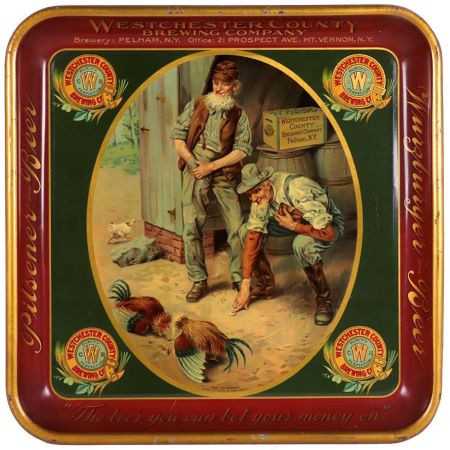The 'Stock' Exchange
American Art Works: "The Cock Fight"
American Art Works: "The Cock Fight"
Date: 1912 - 1913
Size: 13.25" x 13.25"
Type: Pie
Scarcity: Uncommon
Value: $$$ to $$$$
Condition & Brewer Dependent
Size: 13.25" x 13.25"
Type: Pie
Scarcity: Uncommon
Value: $$$ to $$$$
Condition & Brewer Dependent


General
We are not certain whether this design should be officially considered part of the tray stock catalog for American Art Works as we’ve only ever encountered it in tray form from a single brewery (Westchester County of Pelham, NY) and never with a stock number. Certainly, the image was used by several different breweries, but all of those other than the Westchester example are in sign form. The design carries a copyright date of 1912, which is not an entirely reliable indicator of when a tray may have been produced (they frequently lagged by a year or two), but gives an indication of the earliest it may have been produced and some sense of the range where they might fit in the catalog. The catalog is fairly well documented with few gaps from 1910 until probably 1915; the one unaccounted for stock number is 118, so if this is a stock tray design then that would be the likely stock number for it.
Another theory we have mentioned in other write-ups that we have heard is that certain advertisers ended up buying the exclusive rights to what had meant to be a stock design. For example, “Jan” and “Greit” which have clear stock design elements, but for whom the only examples appear to be from the Los Angeles Brewing Co and the Humboldt Brewing Co (an affiliate of Los Angeles Brewing).
We are not certain whether this design should be officially considered part of the tray stock catalog for American Art Works as we’ve only ever encountered it in tray form from a single brewery (Westchester County of Pelham, NY) and never with a stock number. Certainly, the image was used by several different breweries, but all of those other than the Westchester example are in sign form. The design carries a copyright date of 1912, which is not an entirely reliable indicator of when a tray may have been produced (they frequently lagged by a year or two), but gives an indication of the earliest it may have been produced and some sense of the range where they might fit in the catalog. The catalog is fairly well documented with few gaps from 1910 until probably 1915; the one unaccounted for stock number is 118, so if this is a stock tray design then that would be the likely stock number for it.
Another theory we have mentioned in other write-ups that we have heard is that certain advertisers ended up buying the exclusive rights to what had meant to be a stock design. For example, “Jan” and “Greit” which have clear stock design elements, but for whom the only examples appear to be from the Los Angeles Brewing Co and the Humboldt Brewing Co (an affiliate of Los Angeles Brewing).
Click the Picture to Return to Meek & Beach Stock Catalog Page
Thematically, this design straddles the line between rural design (i.e., farm scenes like No. 90, Pride of the Farm, or No. 123, At Peace with Nature) and sporting designs (i.e., No. 88, Colin, or No. 122, Right to the Point). Given the recent negative press surrounding other blood sports like dogfighting, it might strike modern audiences as a strange and off-putting subject for advertising.
Cockfighting in rural America had a long history probably imported from England where it was first documented in George Wilson’s 1607 book, The Commendation of Cocks and Cock Fighting. The English (and Europe) had discovered it from accounts of Magellan's voyage of discovery of the Philippines in 1521 when modern cockfighting was first witnessed and documented for Westerners by the Italian Antonio Pigafetta, Magellan's chronicler, in the Kingdom of Taytay.
Encyclopedia Britannica cites even more ancient roots:
Cockfighting in rural America had a long history probably imported from England where it was first documented in George Wilson’s 1607 book, The Commendation of Cocks and Cock Fighting. The English (and Europe) had discovered it from accounts of Magellan's voyage of discovery of the Philippines in 1521 when modern cockfighting was first witnessed and documented for Westerners by the Italian Antonio Pigafetta, Magellan's chronicler, in the Kingdom of Taytay.
Encyclopedia Britannica cites even more ancient roots:
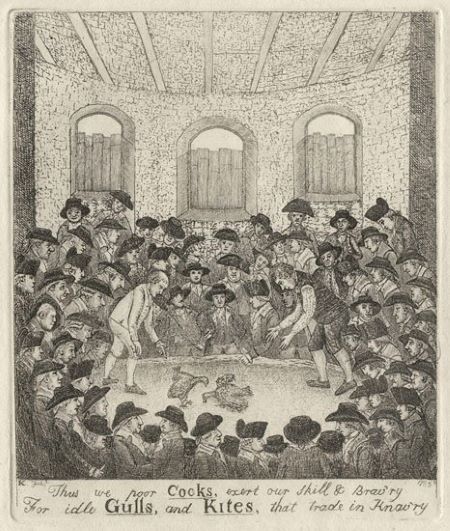
The sport was popular in ancient times in India, China, Persia, and other Eastern countries and was introduced into Ancient Greece in the time of Themistocles (c. 524–460 BC). For a long time, the Romans affected to despise this "Greek diversion", but they ended up adopting it so enthusiastically that the agricultural writer Columella (1st century AD) complained that its devotees often spent their whole patrimony in betting at the side of the pit.
Although now illegal in all 50 states, the District of Columbia and all US territories, the practice was allowed until relatively recently, with Louisiana finally outlawing it in 2008.
Cockfighting was widely practiced on the American frontier and was especially noted in the South. Southerners migrating into the Midwest frequently brought this pastime with them. Rural Midwesterners were not strangers to the sport and where it already existed, however, cockfighting became more common where high concentrations of southerners in the population occurred.
Cockfighting was widely practiced on the American frontier and was especially noted in the South. Southerners migrating into the Midwest frequently brought this pastime with them. Rural Midwesterners were not strangers to the sport and where it already existed, however, cockfighting became more common where high concentrations of southerners in the population occurred.
Cockfights historically took place in cockpits, which are round arenas bounded by wood, plexiglass, or chicken wire. Stadium seating might be offered at more posh facilities, but at "brush pits" (informal locations, not specifically designed for cockfight, such as depicted in this design) an audience might stand or sit on primitive benches or old car seats. Gambling has been central to the pastime, despite the common position by apologists to the contrary.
The owners or trainers tightly hold the birds and allow them to peck at each other; this is termed 'billing"; then the birds would be turned loose from lines drawn in the sand and allowed to peck or lash out with their spurs, which is the action depicted in this design. When they became too entangled to continue, the fight would be stopped, and the cocks carefully separated. Then the fight would recommence from lines drawn in the sand. In more recent times, the natural spur of the chicken was heeled with artificial metal gaffs, which were slightly curved and sharp like ice picks. The ultimate outcome of a fight resulted in the death of one of the participants, although frequently the “winner” was so injured it had to be destroyed as well.
Cockfighting was widely practiced on the American frontier and was especially noted in the South and rural Midwest. In the United States, famous presidents who were lovers of the game were George Washington, Thomas Jefferson, Andrew Jackson, and Abraham Lincoln. It was socially acceptable and encouraged for a gentleman to have a flock of gamecocks and to be an expert on the sport. At one point, the U.S. became a center for cockfighting activities and events. Cockfights were even held in the committee rooms of the president.
Although cockfighting has not been in mainstream culture for a long time, it was depicted in the 1970s mini-series Roots with the character “Chicken George” played by actor Ben Vereen. Although arguably much embellished for dramatic effect, George Lea was an actual person born into slavery in Caswell County North Carolina and was well known by the late 1820s as the top cock fighter in the county.
The owners or trainers tightly hold the birds and allow them to peck at each other; this is termed 'billing"; then the birds would be turned loose from lines drawn in the sand and allowed to peck or lash out with their spurs, which is the action depicted in this design. When they became too entangled to continue, the fight would be stopped, and the cocks carefully separated. Then the fight would recommence from lines drawn in the sand. In more recent times, the natural spur of the chicken was heeled with artificial metal gaffs, which were slightly curved and sharp like ice picks. The ultimate outcome of a fight resulted in the death of one of the participants, although frequently the “winner” was so injured it had to be destroyed as well.
Cockfighting was widely practiced on the American frontier and was especially noted in the South and rural Midwest. In the United States, famous presidents who were lovers of the game were George Washington, Thomas Jefferson, Andrew Jackson, and Abraham Lincoln. It was socially acceptable and encouraged for a gentleman to have a flock of gamecocks and to be an expert on the sport. At one point, the U.S. became a center for cockfighting activities and events. Cockfights were even held in the committee rooms of the president.
Although cockfighting has not been in mainstream culture for a long time, it was depicted in the 1970s mini-series Roots with the character “Chicken George” played by actor Ben Vereen. Although arguably much embellished for dramatic effect, George Lea was an actual person born into slavery in Caswell County North Carolina and was well known by the late 1820s as the top cock fighter in the county.
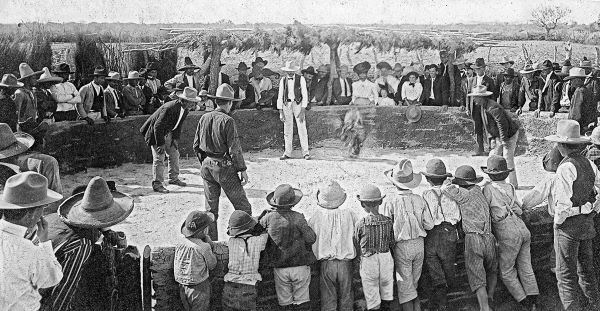
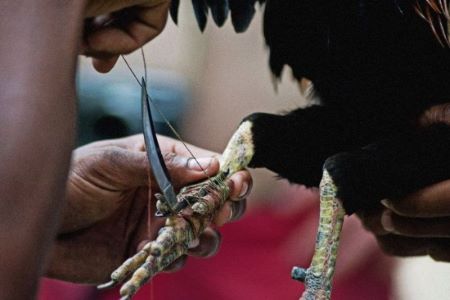
Sahling's Design Notes
There is an entry in Sahling’s workbook in December 1911 for “The Cockfight, stock (21”x25”) which clearly is referring to the SFT sign version of this design. There is no reference to a tray-size version in the rest of Sahling’s workbook.
Shape & Rim & Ad text
As a tray, for which Westchester Brewing is the only example, this appears as a square with an oval image; the only such example we can think of in the Tuscarora/M&B/Meek/American Art Works oeuvre (there are examples of square trays with round images). There are a few details about the Westchester example that are atypical of other stock designs, including being the only oval design on a square shaped tray and the unusually elaborate rim that gives the impression more of a custom design. The Westchester example has a red rim with gold advertising text and gold on the lip of the rim. The remainder of the face not filled by the oval image is green with Westchester logos in each corner making for a fairly elaborate design not typical of stock designs. Most examples are in sign format with a large oval image, which we presume was the original intent for this design. It is possible that Westchester custom ordered a design that American Art Works hadn’t intended for trays.
By this point, AAW/Meek has developed a reliable technique to resize an image. , There are a few details about the Westchester example that are atypical of other stock designs, including being the only oval design on a square shaped tray and the unusually elaborate rim that gives the impression more of a custom design.
Hager & Price
Hager does not discuss this design or include it in his catalog. He may not have recognized it as a possible stock design based on Westchester examples he may have encountered, especially as none of them carry a stock number. Average to slightly better than average tray examples go in the mid-to-upper three figures with better condition versions going well into four figures. SFT sign versions regularly command strong four figures.
There is an entry in Sahling’s workbook in December 1911 for “The Cockfight, stock (21”x25”) which clearly is referring to the SFT sign version of this design. There is no reference to a tray-size version in the rest of Sahling’s workbook.
Shape & Rim & Ad text
As a tray, for which Westchester Brewing is the only example, this appears as a square with an oval image; the only such example we can think of in the Tuscarora/M&B/Meek/American Art Works oeuvre (there are examples of square trays with round images). There are a few details about the Westchester example that are atypical of other stock designs, including being the only oval design on a square shaped tray and the unusually elaborate rim that gives the impression more of a custom design. The Westchester example has a red rim with gold advertising text and gold on the lip of the rim. The remainder of the face not filled by the oval image is green with Westchester logos in each corner making for a fairly elaborate design not typical of stock designs. Most examples are in sign format with a large oval image, which we presume was the original intent for this design. It is possible that Westchester custom ordered a design that American Art Works hadn’t intended for trays.
By this point, AAW/Meek has developed a reliable technique to resize an image. , There are a few details about the Westchester example that are atypical of other stock designs, including being the only oval design on a square shaped tray and the unusually elaborate rim that gives the impression more of a custom design.
Hager & Price
Hager does not discuss this design or include it in his catalog. He may not have recognized it as a possible stock design based on Westchester examples he may have encountered, especially as none of them carry a stock number. Average to slightly better than average tray examples go in the mid-to-upper three figures with better condition versions going well into four figures. SFT sign versions regularly command strong four figures.
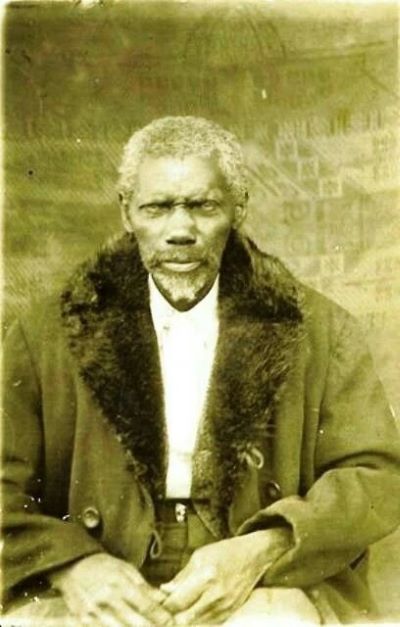
Confirmed Brewer used Stock Trays
Non-Beer Related & Non-Tray Uses
Though cock fighting is illegal in every US State, it is still legal in Mexico and often controlled by the cartels, where high-stakes gambling is common and often used for money laundering.
Both Cerveceria Cruz Blanca & Cerveceria Cuauhtemoc Moctezuma (Carta Blanca) celebrated blood-sports in trays in the 1940's. Most often bull fighting, but Carta Blanca also used a very festive tray featuring Senoritas laughing and having fun as they watch the birds fight. Different times for sure, as highly unlikely this type of advertising would be viewed as acceptable in these PC times.
Both Cerveceria Cruz Blanca & Cerveceria Cuauhtemoc Moctezuma (Carta Blanca) celebrated blood-sports in trays in the 1940's. Most often bull fighting, but Carta Blanca also used a very festive tray featuring Senoritas laughing and having fun as they watch the birds fight. Different times for sure, as highly unlikely this type of advertising would be viewed as acceptable in these PC times.

